Study of Microstructural and Mechanical Properties of Al/SiC/TiO2 Hybrid Nanocomposites Developed by Microwave Sintering
Abstract
1. Introduction
2. Experimental Details
2.1. Selection of Raw Materials
2.2. Preparations of Hybrid Nanocomposite Samples
2.3. Characterization
3. Results and Discussion
3.1. Density and Porosity
3.2. Phase Identification
3.3. Microstructure Behavior
3.4. Surface Roughness
3.5. Vickers Microhardness
3.6. Nanohardness
3.7. Compression and Yield Strength
3.8. Fractography
4. Conclusions
Author Contributions
Funding
Acknowledgments
Conflicts of Interest
References
- Perov, B.V.; Khoroshilova, I.P. Hybrid Composite Materials BT—Polymer Matrix Composites; Shalin, R.E., Ed.; Springer: Dordrecht, The Netherlands, 1995; pp. 269–304. ISBN 978-94-011-0515-6. [Google Scholar]
- Yamada, A.; Sasabe, H.; Osada, Y.; Shiroda, Y. Concept of hybrid materials, hybrid materials-concept and case studies. ASM Int. 1989, 18. [Google Scholar]
- Chavhan, G.R.; Wankhade, L.N. Improvement of the mechanical properties of hybrid composites prepared by fibers, fiber-metals, and nano-filler particles—A review. Mater. Today Proc. 2019, 27, 72–82. [Google Scholar] [CrossRef]
- Vieira, C.A.B.; Susin, S.B.; Freire, E.; Amico, S.C.; Zattera, A.J. Characterization of hybrid composites produced with mats made using different methods. Mater. Res. 2009, 12, 433–436. [Google Scholar] [CrossRef][Green Version]
- Pitchayyapillai, G.; Seenikannan, P.; Raja, K.R.; Chandrasekaran, K. Al6061 Hybrid Metal Matrix Composite Reinforced with Alumina and Molybdenum Disulphide. Adv. Mater. Sci. Eng. 2016, 2016, 1–9. [Google Scholar] [CrossRef]
- Bodunrin, M.O.; Alaneme, K.K.; Chown, L.H. Aluminium matrix hybrid composites: A review of reinforcement philosophies; Mechanical, corrosion and tribological characteristics. J. Mater. Res. Technol. 2015, 4, 434–445. [Google Scholar] [CrossRef]
- Ahamed, H.; Senthilkumar, V. Hybrid Aluminium Metal Matrix Composites and Reinforcement Materials: A Review. Int. J. Innov. Res. Sci. Eng. Technol. 2016, 5, 6284–6288. [Google Scholar]
- Rino, J.J.; Chandramohan, D.; Sucitharan, K.S. An Overview on Development of Aluminium Metal Matrix Composites with Hybrid Reinforcement. IJSR India Online ISSN 2012, 1, 2319–7064. [Google Scholar]
- Bhatia, R.S. An Experimental Analysis of Aluminium Metal Matrix Composite using Al2O3/B4C/Gr Particles. Int. J. Adv. Res. Comput. Sci. 2017, 8, 83–90. [Google Scholar] [CrossRef]
- Mavhungu, S.T.; Akinlabi, E.T.; Onitiri, M.A.; Varachia, F.M. Aluminum Matrix Composites for Industrial Use: Advances and Trends. Procedia Manuf. 2017, 7, 178–182. [Google Scholar] [CrossRef]
- Singh, J.; Chauhan, A. Characterization of hybrid aluminum matrix composites for advanced applications—A review. J. Mater. Res. Technol. 2016, 5, 159–169. [Google Scholar] [CrossRef]
- Kanthavel, K.; Sumesh, K.R.; Saravanakumar, P. Study of tribological properties on Al/Al2O3/MoS2 hybrid composite processed by powder metallurgy. Alex. Eng. J. 2016, 55, 13–17. [Google Scholar] [CrossRef]
- Murthy, K.V.S.; Girish, D.P.; Varol, T.; Koppad, G.P. Mechanical and thermal properties of AA7075/TiO2 /Fly ash hybrid composites obtained by hot forging. Prog. Nat. Sci. 2017, 27, 474–481. [Google Scholar] [CrossRef]
- Sambathkumar, M.; Navaneethakrishnan, P.; Ponappa, K.; Sasikumar, K.S.K. Mechanical and Corrosion Behavior of Al7075 (Hybrid) Metal Matrix Composites by Two Step Stir Casting Process. Lat. Am. J. Solids Struct. 2016, 14, 243–255. [Google Scholar] [CrossRef]
- Matli, P.R.; Fareeha, U.; Shakoor, R.A.; Mohamed, A.M.A. A comparative study of structural and mechanical properties of Al-Cu composites prepared by vacuum and microwave sintering techniques. J. Mater. Res. Technol. 2018, 7, 165–172. [Google Scholar] [CrossRef]
- Ghasali, E.; Pakseresht, A.; Rahbari, A.; Eslami-shahed, H.; Alizadeh, M.; Ebadzadeh, T. Mechanical properties and microstructure characterization of spark plasma and conventional sintering of Al–SiC–TiC composites. J. Alloys Compd. 2016, 666, 366–371. [Google Scholar] [CrossRef]
- Khan, A.; Matli, P.R.; Nawaz, M.; Mattli, M.R. Microstructure and Mechanical Behavior of Hot Extruded Aluminum/Tin-Bismuth Composites Produced by Powder Metallurgy. Appl. Sci. 2020, 10, 2812. [Google Scholar] [CrossRef]
- Oghbaei, M.; Mirzaee, O. Microwave Versus Conventional Sintering: A Review of Fundamentals, Advantages and Applications. J. Alloys Compd. 2010, 494, 175–189. [Google Scholar] [CrossRef]
- Chandrasekaran, S.; Ramanathan, S.; Basak, T. Microwave material processing—A review. AIChE J. 2012, 58, 330–363. [Google Scholar] [CrossRef]
- Matli, P.; Shakoor, R.; Amer Mohamed, A.; Gupta, M. Microwave Rapid Sintering of Al-Metal Matrix Composites: A Review on the Effect of Reinforcements, Microstructure and Mechanical Properties. Metals 2016, 6, 143. [Google Scholar] [CrossRef]
- Fliflet, A.W.; Bruce, R.W.; Kinkead, A.K.; Fischer, R.P.; Lewis, D.; Rayne, R.; Bender, B.; Kurihara, L.K.; Chow, G.-M.; Schoen, P.E. Application of microwave heating to ceramic processing: Design and initial operation of a 2.45-GHz single-mode furnace. IEEE Trans. Plasma Sci. 1996, 24, 1041–1049. [Google Scholar] [CrossRef]
- Agarwal, D. Microwave sintering of ceramics, composites and metallic materials, and melting of glasses. Trans. Ind. Ceram. Soc. 2006, 65, 129–144. [Google Scholar] [CrossRef]
- Matli, P.R.; Manakari, V.; Parande, G.; Mattli, M.R.; Shakoor, R.A.; Gupta, M. Improving Mechanical, Thermal and Damping Properties of NiTi (Nitinol) Reinforced Aluminum Nanocomposites. J. Compos. Sci. 2020, 4, 19. [Google Scholar] [CrossRef]
- Reddy, M.P.; Shakoor, R.A.; Parande, G.; Manakari, V.; Ubaid, F.; Mohamed, A.M.A.; Gupta, M. Enhanced performance of nano-sized SiC reinforced Al metal matrix nanocomposites synthesized through microwave sintering and hot extrusion techniques. Prog. Nat. Sci. Mater. Int. 2017, 27, 606–614. [Google Scholar] [CrossRef]
- Karantzalis, A.E.; Wyatt, S.; Kennedy, A.R. The mechanical properties of Al-TiC metal matrix composites fabricated by a flux-casting technique. Mater. Sci. Eng. A 1997, 237, 200–206. [Google Scholar] [CrossRef]
- Hossein-Zadeh, M.; Razavi, M.; Mirzaee, O.; Ghaderi, R. Characterization of properties of Al–Al2O3 nano-composite synthesized via milling and subsequent casting. J. King Saud Univ. Eng. Sci. 2013, 25, 75–80. [Google Scholar] [CrossRef]
- Mattli, M.R.; Shakoor, A.; Matli, P.R.; Mohamed, A.M.A. Microstructure and compressive behavior of Al–Y2O3 nanocomposites prepared by microwave-assisted mechanical alloying. Metals 2019, 9, 414. [Google Scholar] [CrossRef]
- Ravichandran, M.; Meignanamoorthy, M.; Dineshkumar, S. Microstructure and Properties of Hot Extruded Al-TiO2 Powder Metallurgic Composites. Appl. Mech. Mater. 2016, 852, 130–135. [Google Scholar] [CrossRef]
- Parveen, A.; Chauhan, N.; Suhaib, M. Mechanical and Tribological Behaviour of Al-ZrO2 Composites: A Review. In Lecture Notes in Mechanical Engineering; Springer: Singapore, 2019; pp. 217–229. [Google Scholar]
- Moradi, M.R.; Moloodi, A.; Habibolahzadeh, A. Fabrication of Nano-composite Al-B 4 C Foam via Powder Metallurgy-Space Holder Technique. Procedia Mater. Sci. 2015, 11, 553–559. [Google Scholar] [CrossRef]
- Mattli, M.; Matli, P.; Shakoor, A.; Amer Mohamed, A. Structural and Mechanical Properties of Amorphous Si3N4 Nanoparticles Reinforced Al Matrix Composites Prepared by Microwave Sintering. Ceramics 2019, 2, 12. [Google Scholar] [CrossRef]
- Järrendahl, K.; Davis, R.F. Chapter 1 Materials Properties and Characterization of SiC. In Semiconductors and Semimetals; Soo Park, Y.B.T.-S., Ed.; Elsevier: Amsterdam, The Netherlands, 1998; Volume 52, pp. 1–20. ISBN 0080-8784. [Google Scholar]
- Choyke, W.J.; Pensl, G. Physical Properties of SiC. MRS Bull. 1997, 22, 25–29. [Google Scholar] [CrossRef]
- Goodfellow Titanium Dioxide—Titania (TiO2). Available online: http://www.goodfellow.com/E/Titanium-Dioxide.html (accessed on 5 August 2021).
- Kusior, A.; Banas, J.; Trenczek-Zajac, A.; Zubrzycka, P.; Micek-Ilnicka, A.; Radecka, M. Structural properties of TiO2 nanomaterials. J. Mol. Struct. 2018, 1157, 327–336. [Google Scholar] [CrossRef]
- Prabu, S.B.; Karunamoorthy, L.; Kathiresan, S.; Mohan, B. Influence of stirring speed and stirring time on distribution of particles in cast metal matrix composite. J. Mater. Process. Technol. 2006, 171, 268–273. [Google Scholar] [CrossRef]
- Elango, G.; Raghunath, B.K. Tribological behavior of hybrid (LM25Al + SiC+ TiO2) metal matrix composites. Procedia Eng. 2013, 64, 671–680. [Google Scholar] [CrossRef]
- Nassar, A.E.; Nassar, E.E. Properties of aluminum matrix Nano composites prepared by powder metallurgy processing. J. King Saud Univ. Eng. Sci. 2017, 29, 295–299. [Google Scholar] [CrossRef]
- Reddy, M.P.; Ubaid, F.; Shakoor, R.A.; Parande, G.; Manakari, V.; Mohamed, A.M.A.; Gupta, M. Effect of reinforcement concentration on the properties of hot extruded Al-Al2O3 composites synthesized through microwave sintering process. Mater. Sci. Eng. A 2017, 696, 60–69. [Google Scholar] [CrossRef]
- Cheng, H.; Tu, R.; Zhang, S.; Han, M.; Goto, T.; Zhang, L. Preparation of highly oriented β-SiC bulks by halide laser chemical vapor deposition. J. Eur. Ceram. Soc. 2017, 37, 509–515. [Google Scholar] [CrossRef]
- Xing, J.; Li, Y.H.; Jiang, H.B.; Wang, Y.; Yang, H.G. The size and valence state effect of Pt on photocatalytic H2 evolution over platinized TiO2 photocatalyst. Int. J. Hydrog. Energy 2014, 39, 1237–1242. [Google Scholar] [CrossRef]
- Krishna, M.V.; Xavior, M.A. Experiment and Statistical Analysis of End Milling Parameters for Al/SiC Using Response Surface Methodology. Int. J. Eng. Technol. 2015, 7, 2274–2285. [Google Scholar]
- Suarsana, K.; Astika, I.M.; Sunu, P.W. Properties of thermal conductivity, density and hardness of aluminium matrices with reinforcement of sicw/Al2O3 hybrid after sintering process. IOP Conf. Ser. Mater. Sci. Eng. 2019, 539, 012016. [Google Scholar] [CrossRef]
- Mokhtar, N.M.; Lau, W.J.; Ismail, A.F.; Ng, B.C. The physicochemical study of polyvinylidene fluoride-Cloisite15A® composite membranes for membrane distillation application. RSC Adv. 2014, 4, 63367–63379. [Google Scholar] [CrossRef]
- Thiagarajan, R.; Palanikumar, K.; Arumugam, S. Synthesis and characterization of sintered hybrid aluminium matrix composites reinforced with nanocopper oxide particles and microsilicon carbide particles. Compos. Part. B Eng. 2014, 59, 43–49. [Google Scholar]
- Ghanaraja, S.; Dileep Kumar, D.J.; Ravikumar, K.S.; Madhusudan, B.M. Mechanical Properties of Hot Extruded Al (Mg)-MnO2 Composites. Appl. Mech. Mater. 2015, 813–814, 84–89. [Google Scholar] [CrossRef]
- Mohapatra, S.; Mishra, D.K.; Mishra, G.; Roy, G.S.; Behera, D.; Mantry, S.; Singh, S.K. A study on sintered TiO2 and TiO2/SiC composites synthesized through chemical reaction based solution method. J. Compos. Mater. 2013, 47, 3081–3089. [Google Scholar] [CrossRef]
- Zhang, Z.; Chen, D.L. Contribution of Orowan strengthening effect in particulate-reinforced metal matrix nanocomposites. Mater. Sci. Eng. A 2008, 483–484, 148–152. [Google Scholar] [CrossRef]
- Denry, I.L.; Holloway, J.A. Elastic constants, Vickers hardness, and fracture toughness of fluorrichterite-based glass-ceramics. Dent. Mater. 2004, 20, 213–219. [Google Scholar] [CrossRef]
- Gladman, T. Precipitation hardening in metals. Mater. Sci. Technol. 1999, 15, 30–36. [Google Scholar] [CrossRef]
- DeGarmo, E.P.; Black, J.T.; Kohser, A.R. Materials and Processes in Manufacturing, 10th ed.; Wiley: Hoboken, NJ, USA, 2008; ISBN 9780470055120. [Google Scholar]
- Taya, M. Strengthening Mechanisms of Metal Matrix Composites. Mater. Trans. JIM 1991, 32, 1–19. [Google Scholar] [CrossRef]
- Kim, J.G.; Enikeev, N.A.; Seol, J.B.; Abramova, M.M.; Karavaeva, M.V.; Valiev, R.Z.; Park, C.G.; Kim, H.S. Superior Strength and Multiple Strengthening Mechanisms in Nanocrystalline TWIP Steel. Sci. Rep. 2018, 8, 1–10. [Google Scholar] [CrossRef]
- Callister, W.D.; Rethwisch, D.G. Fundamentals of Materials Science and Engineering, 3rd ed.; John Wiley & Sons, Inc.: Hoboken, NJ, USA, 2000; ISBN 9780470125373. [Google Scholar]
- Ardell, A.J. Precipitation hardening. Metall. Trans. A 1985, 16, 2131–2165. [Google Scholar] [CrossRef]
- Nardone, V.C.; Prewo, K.M. On the strength of discontinuous silicon carbide reinforced aluminum composites. Scr. Metall. 1986, 20, 43–48. [Google Scholar] [CrossRef]
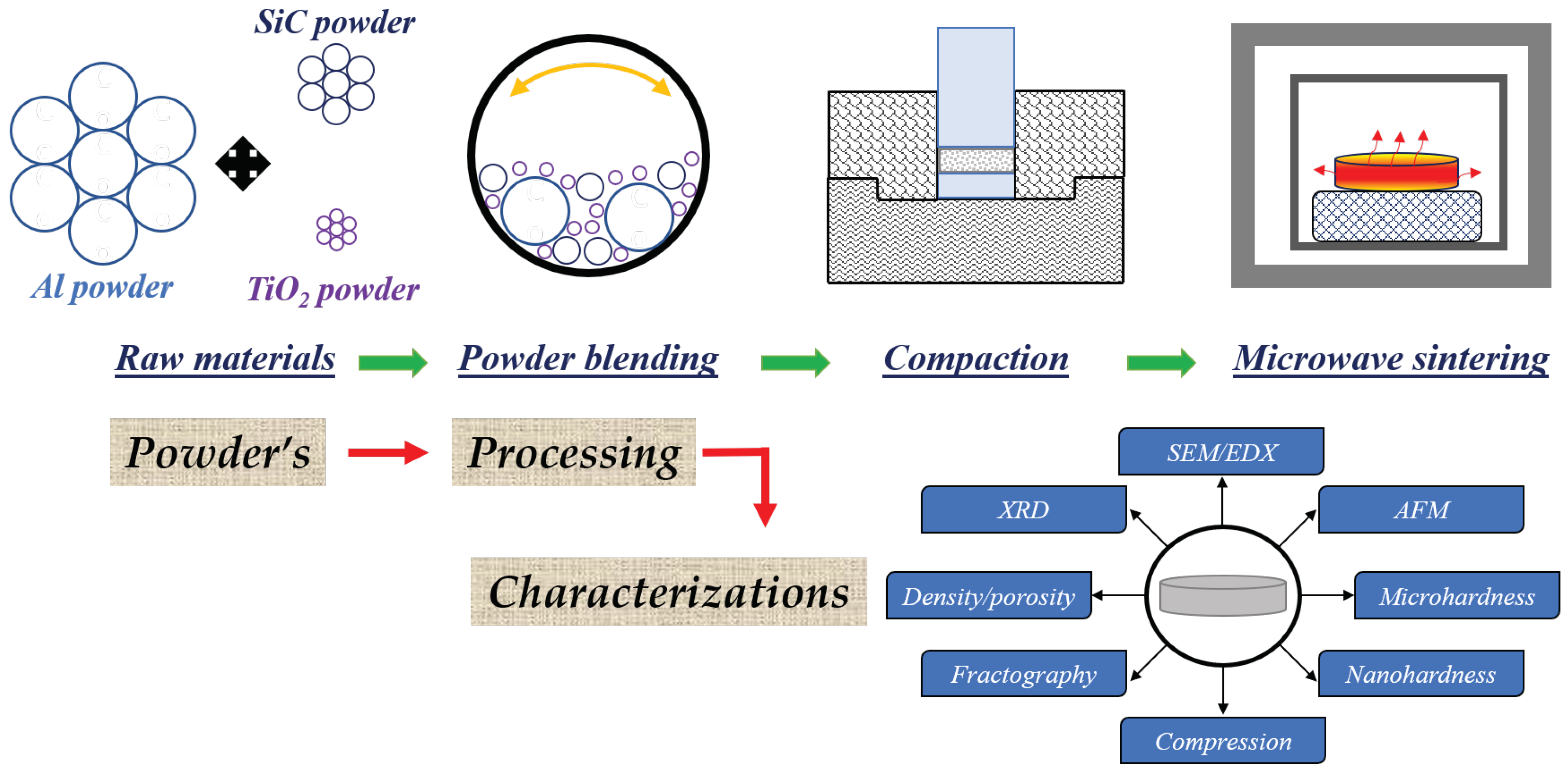
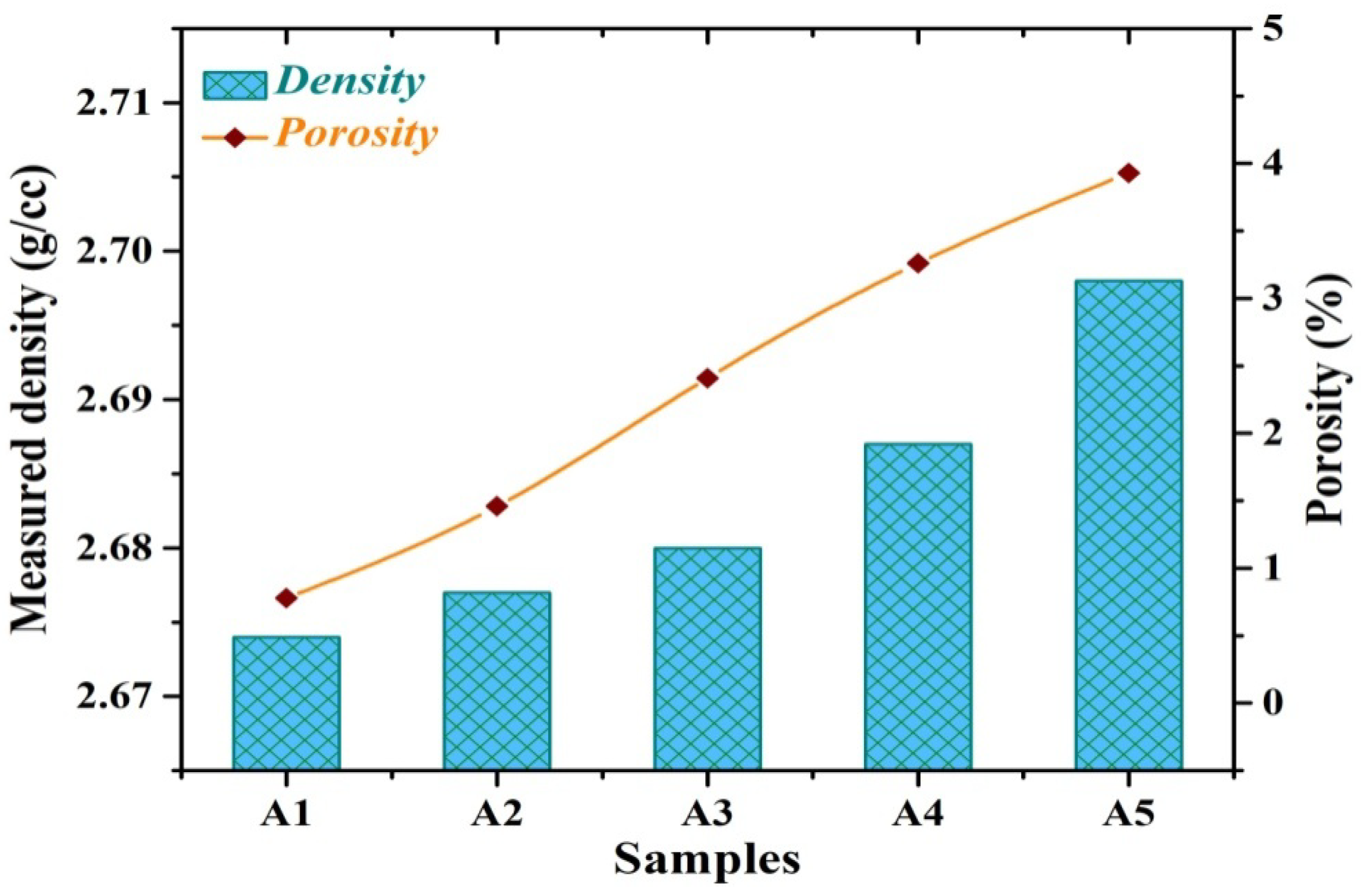
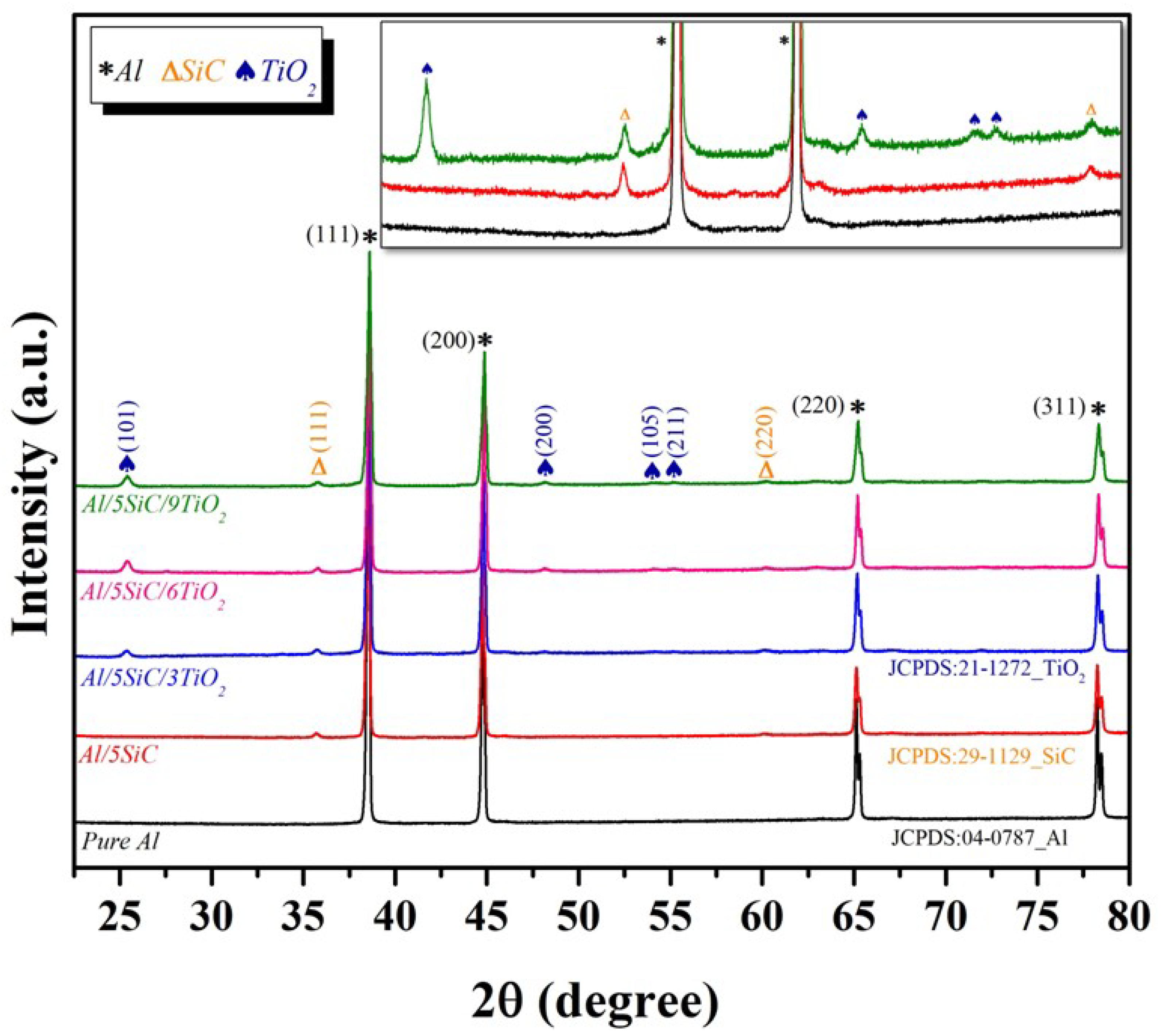
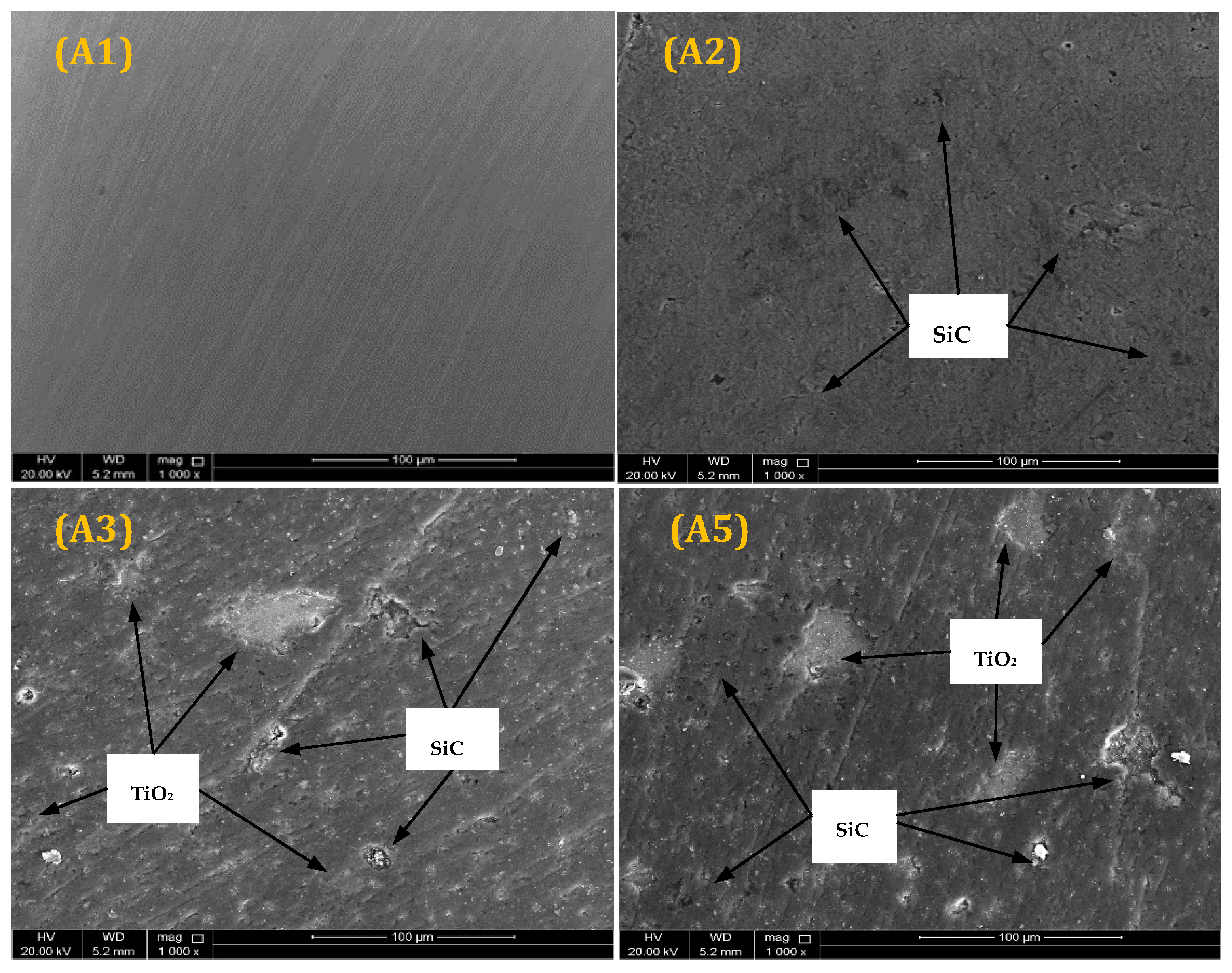
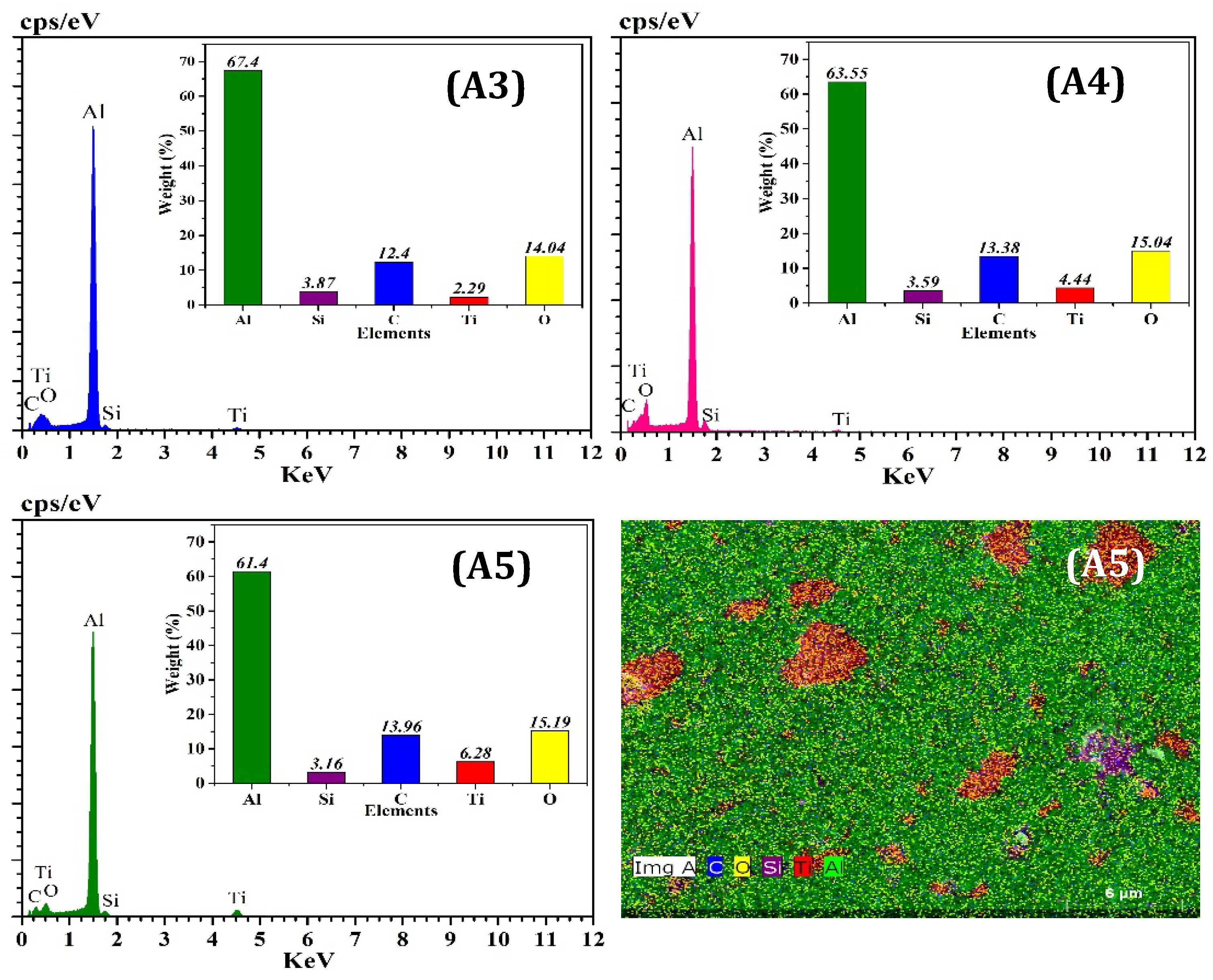

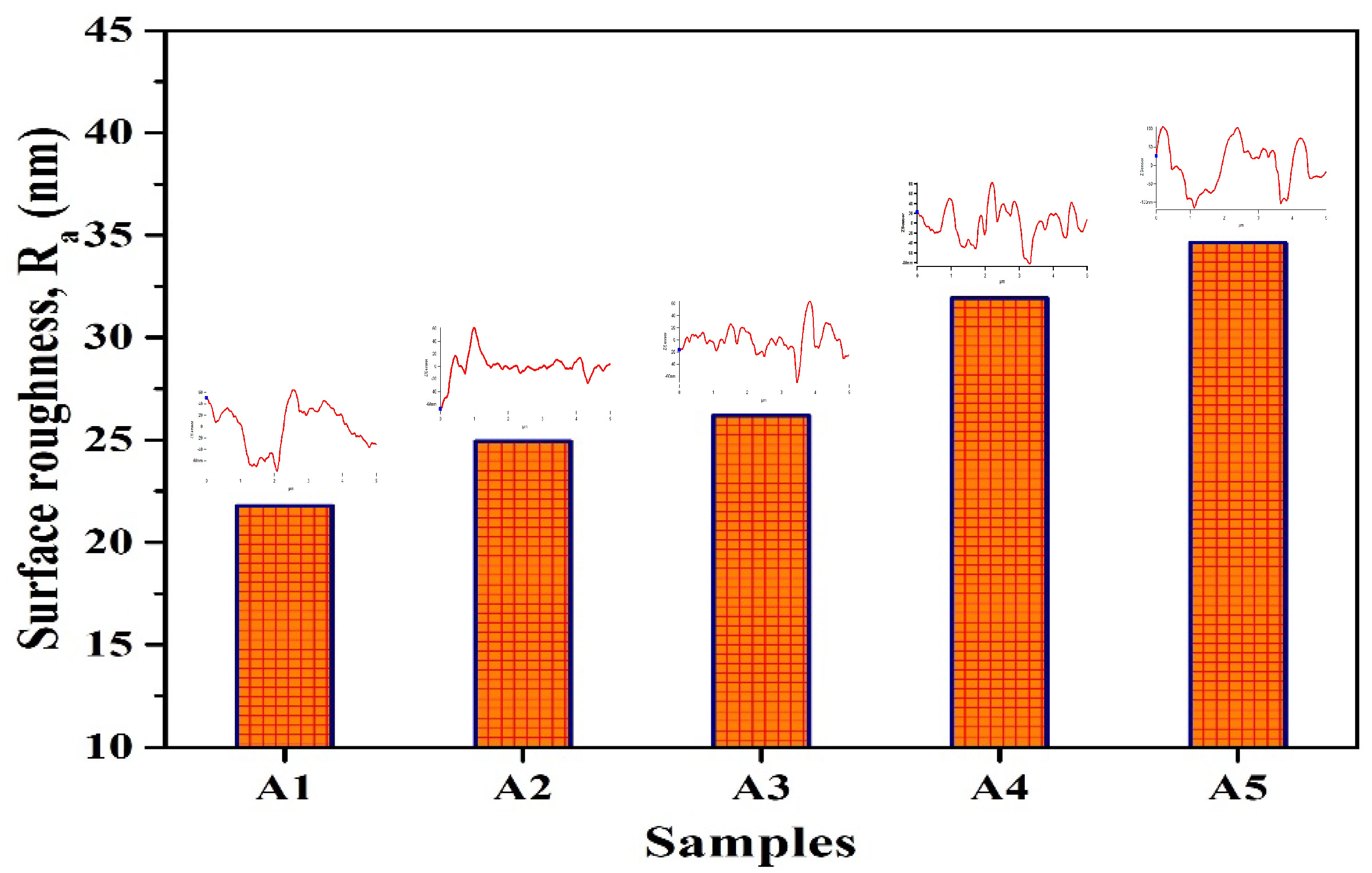

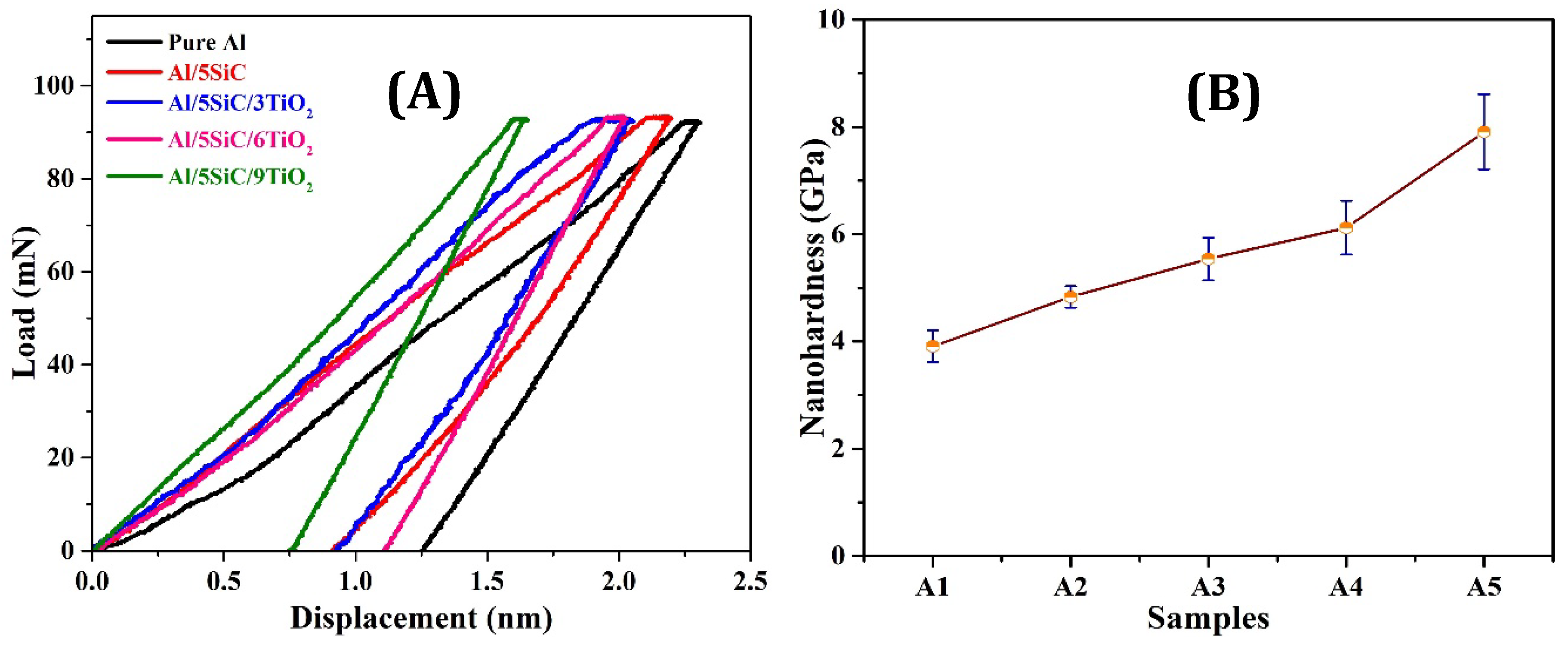

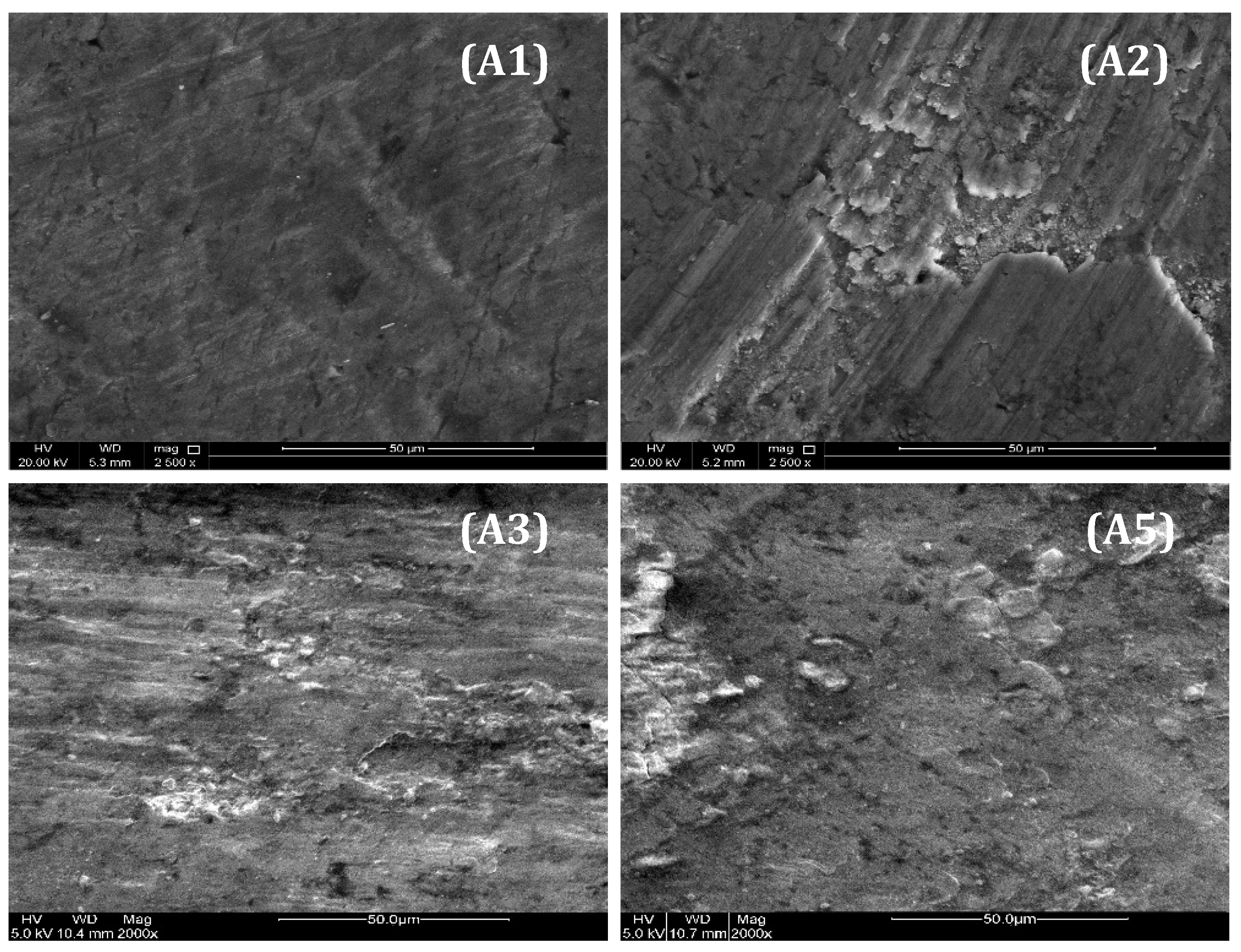
| S. No: | Particles | Purity (%) | Particle Size | Density (g/cc) | Suppliers |
|---|---|---|---|---|---|
| 1 | Al | 99.5 | 7–15 µm | 2.70 | Alfa Aesar |
| 2 | SiC (b-phase) | --- | 44–55 nm | 3.21 | Alfa Aesar |
| 3 | TiO2 (anatase) | 99.7 | 15 nm | 4.23 | Alfa Aesar |
| Specimens | Compositions | Microhardness (Hv) | Nanoindentation (GPa) | UCS (MPa) | CYS (MPa) | Failure Strain (%) |
|---|---|---|---|---|---|---|
| A1 | Al | 37 ± 3 | 3.91 ± 0.3 | 305 ± 6 | 73 ± 5 | >63 |
| A2 | Al/5SiC | 64 ± 4 | 4.83 ± 0.2 | 330 ± 3 | 89 ± 6 | >63 |
| A3 | Al/5SiC/3TiO2 | 70 ± 5 | 5.54 ± 0.4 | 346 ± 5 | 117 ± 5 | >63 |
| A4 | Al/5SiC/6TiO2 | 75 ± 6 | 6.12 ± 0.5 | 359 ± 4 | 126 ± 6 | >63 |
| A5 | Al/5SiC/9TiO2 | 83 ± 3 | 7.91 ± 0.7 | 375 ± 6 | 139 ± 8 | >63 |
Publisher’s Note: MDPI stays neutral with regard to jurisdictional claims in published maps and institutional affiliations. |
© 2021 by the authors. Licensee MDPI, Basel, Switzerland. This article is an open access article distributed under the terms and conditions of the Creative Commons Attribution (CC BY) license (https://creativecommons.org/licenses/by/4.0/).
Share and Cite
Mattli, M.R.; Matli, P.R.; Khan, A.; Abdelatty, R.H.; Yusuf, M.; Ashraf, A.A.; Kotalo, R.G.; Shakoor, R.A. Study of Microstructural and Mechanical Properties of Al/SiC/TiO2 Hybrid Nanocomposites Developed by Microwave Sintering. Crystals 2021, 11, 1078. https://doi.org/10.3390/cryst11091078
Mattli MR, Matli PR, Khan A, Abdelatty RH, Yusuf M, Ashraf AA, Kotalo RG, Shakoor RA. Study of Microstructural and Mechanical Properties of Al/SiC/TiO2 Hybrid Nanocomposites Developed by Microwave Sintering. Crystals. 2021; 11(9):1078. https://doi.org/10.3390/cryst11091078
Chicago/Turabian StyleMattli, Manohar Reddy, Penchal Reddy Matli, Adnan Khan, Rokaya Hamdy Abdelatty, Moinuddin Yusuf, Abdulla Al Ashraf, Rama Gopal Kotalo, and Rana Abdul Shakoor. 2021. "Study of Microstructural and Mechanical Properties of Al/SiC/TiO2 Hybrid Nanocomposites Developed by Microwave Sintering" Crystals 11, no. 9: 1078. https://doi.org/10.3390/cryst11091078
APA StyleMattli, M. R., Matli, P. R., Khan, A., Abdelatty, R. H., Yusuf, M., Ashraf, A. A., Kotalo, R. G., & Shakoor, R. A. (2021). Study of Microstructural and Mechanical Properties of Al/SiC/TiO2 Hybrid Nanocomposites Developed by Microwave Sintering. Crystals, 11(9), 1078. https://doi.org/10.3390/cryst11091078









